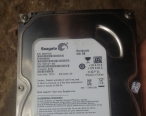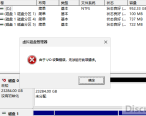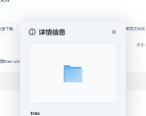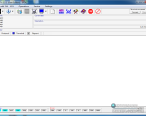|
|
希捷11代12代硬盘固件门F3修复指令详解
(1) ASCII Diagnostic Mode
This mode is enabled by Control-Z. In this mode, the drive will respond to all ASCII commands described in this document. It will not respond to ESLIP encoded packets received over the serial port interface. In this mode, the native interface (SATA, SCSI, SAS, FC) is not alive.
- Entering a Control-Z character from YASPP (or any similar host serial port program) while the drive serial port is in ESLIP mode or ASCII Online mode will switch the serial port to ASCII Diagnostic mode.
- Entering a Control-R character while the drive serial port is in ASCII Diagnostic mode will switch the serial port to ASCII Online mode. In this mode, the native interface (SATA, SCSI, SAS, FC) is alive.
- Entering a Control-T character while the drive serial port is in ASCII Diagnostic mode will switch the serial port to ESLIP mode.
(2) Initialize Defect List (Level T 'i')
Description:This command initializes the Defect List to contain no defects.
Quick Help:
"InitDefectList, i[DefectListSelect],[SaveListOpt],[ValidKey]";
Input Parameters:
0 - List Selection.
This parameter is a bit significant value that specifies which defect lists are to be initialized. Setting a bit indicates that the corresponding defect list is to be initialized.
bits 31-3: Reserved for possible use for additional lists
bit 2: User Alt List
bit 1: Reserved (ignored)
bit 0: User Slip List
Type: Unsigned 32-bit value
Range: 1 or 4 or 5
Default: None
1 - Action
0 - defects will be cleared in the current, volatile, copy of the defect list(s) in RAM , but lists won't be written to disk, modification is TEMPORARY .
1 - modified ( cleared ) versions of defect lists will be written
to disk, defects are PERMANENTLY cleared.
2 - the defect list will be read from non-volatile memory, overwriting
any changes in volatile memory.
Type: Unsigned 32-bit value
Range: 0 to 2
Default: 0
2 - Valid Command Key.
This parameter must be equal to 22 Hex. If this parameter is not equal to 22 Hex, the command will not be executed.
Type: Unsigned 8-bit value
Range: 0x22
Default: None
Output Data:
If an error occurred, the following information will be displayed.
"DiagError aaaaaaaa " where aaaaaaaa is the Diagnostic Error Code
Examples:
Example #1:
To initialize the slip list to zeros:
T> i1,,22
Example #2:
To initialize the alt list to zeroes and save the zeroed list to disk:
T> i4,1,22
Example #3:
To reread the alt list from disk:
T> i4,2,22
(3). SMART Control (Level 1 'N')
Description:
Performs several diagnostic SMART functions.
Quick Help:
"SmartControl, N[SubCmd],[SubCmdParm0],[SubCmdParm1]";
Input Parameters:
0 - Serial Port Command.
This parameter defines which command will be used on the SMART Serial Port. The following are the allowable commands.
0x01: INITIALIZE_SMART_DATA - initializes SMART statistics data (both in RAM and SMART sectors). Also initializes Fast Flush and Media Cache on the disk.
0x05: DUMP_SMART_ATTRIBUTES - retrieves SMART's attributes.
0x06: DUMP_SMART_THRESHOLDS - retrieves SMART's thresholds.
0x08: DUMP_CE_LOG - retrieves the critical event log.
0x23: CLEAR_PERSISTENT_INFO - clears persistent information.
0xFF: NO_COMMAND
Type: Unsigned 8-bit value
Range: 0x00 to 0x23
Default: None
1 - Variable Parameter
Multi-purpose parameter. Used in command 01 to initialize Fast Flush and Media cache. Used in command 03 as the number of the attribute to change.
Type: Unsigned 16-bit value
Range: 0 to 0xFFFF
Default: None
2 - Boolean Bit Value.
Used in command 03 to set/clear the boolean value for the bit.
Type: Boolean value
Range: 0 to 0x1
Default: None
Output Data:
If an error occurred, the following information will be displayed.
"DiagError aaaaaaaa " where aaaaaaaa is the Diagnostic Error Code
N1 - initialize Smart data
N5 - display attribute values
N6 - display threshold values
(4). Format Partition (Level T 'm')
Description: This command formats the specified partition.
Quick Help:
"FormatPartition, m[Partition],[FormatOpts],[DefectListOpts],[MaxWrRetryCnt],[MaxRdRetryCnt],[MaxEccTLevel],[MaxCertifyTrkRewrites],[ValidKey],[DataPattern]";
Input Parameters:
0 - Partition Number.
This parameter specifies the media partition to be formatted.
0 = User Partition
1 = System Partition
Type: Unsigned 8-bit value
Range: 0 or 1
Default: 0
1 - Format Options.
This parameter is a bit significant value that selects the following options:
Bits 31-6: not used
Bit 5: Enable SeaCOS XF Space Format.
This bit is only valid when the User Partition is selected. If this bit is equal to 1, the the Format Partition command will only format SeaCOS Extended File (XF) space.
NOTE: This feature can be enabled or disabled at compile-time. Use the quick help to determine whether your code supports this feature.
Bit 4: Enable Zone Re-format Skipping.
If this bit is equal to 1, then the Format Partition command will enable the zone re-format skipping mode during the format operation. With this mode enabled, the format operation will not re-format a zone if grown defects were found in the zone.
NOTE: This feature can be enabled or disabled at compile-time. Use the quick help to determine whether your code supports this feature.
Bit 3: Enable Event-based Format Logging.
If this bit is equal to 1, then the Format Partition command will display information about error events that occur during the format operation. This information will be displayed as interim status as these events occur.
NOTE: This feature can be enabled or disabled at compile-time. Use the quick help to determine whether your code supports this feature.
Bit 2: Disable User Partition Certify.
This bit is only valid when the User Partition is selected. If this bit is equal to 1, media certification and defect deallocation will be disabled.
Bit 1: Disable User Partition Format.
This bit is only valid when the User Partition is selected. If this bit is equal to 1, the User Partition sectors will not be written with a constant data pattern.
Bit 0: Corrupt User Partition Primary Defects.
This bit is only valid when the User Partition is selected. If this bit is equal to 1, the primary defective sectors will be corrupted.
Type: Unsigned 32-bit value
Range: 0 or 0xFFFFFFFF
Default: 0 (Enable User partition Certify,
Enable User Partition Format,
Don't Corrupt Primary Defects)
2 - Defect List Options.
This parameter is a bit significant value that selects the following options:
Bits 31-3: not used
Bit 2: Process the Active Error Log.
This bit is only valid when the User Partition is selected. If this bit is equal to 1, the Format Client Defect List will be written with contents of the Active Error Log and the option to process the Client Defect List will be enabled. If there is no Active Error Log or there are no R/W-related entries in the Active Error Log, then this bit will be ignored.
Bit 1: Process Primary Defect Lists.
This bit is only valid when the User Partition is selected. If this bit is equal to 1, the Primary Defect Lists will be used when creating the defect list to be used by the format operation.
Bit 0: Process Grown Defect Lists.
This bit is only valid when the User Partition is selected. If this bit is equal to 1, the the Grown Defect Lists will be used when creating the defect list to be used by the format operation.
Type: Unsigned 32-bit value
Range: 0 or 0xFFFFFFFF
Default: 0x00000003 (Process Grown Defect Lists,
Process Primary Defect Lists,
Do not process the Active Error Log)
3 - Maximum Write Retry Count.
If this parameter is entered, the maximum write retry count will be set to the specified value. This parameter is only valid when the User Partition is being formatted (Parameter 0 is equal to 0). If this parameter is not entered, the maximum write retry count will not be changed.
Type: Unsigned 16-bit value
Range: 0 or 0xFFFF
Default: None.
4 - Maximum Read Retry Count.
If this paremeter is entered, the maximum read retry count will be set to the specified value. This parameter is only valid when the User Partition is being formatted (Parameter 0 is equal to 0). If this parameter is not entered, the maximum read retry count will not be changed.
Type: Unsigned 16-bit value
Range: 0 or 0xFFFF
Default: None.
5 - Maximum ECC T-Level.
If this paremeter is entered, the maximum ECC T-Level will be set to the specified value. This parameter is only valid when the User Partition is being formatted (Parameter 0 is equal to 0). If this parameter is not entered, the ECC T-Level will not be changed.
Type: Unsigned 16-bit value
Range: 0 or 0xFFFF
Default: None.
6 - Track Rewrite During Certify Retry Threshold.
If this parameter is entered, it specifies the maximum number of rewrite retries to be performed during the user partition certification pass.
Type: Unsigned 16-bit value
Range: 0 or 0xFFFF
Default: None. If this parameter is not entered, the default value recommended by the R/W Firmware will be used.
7 - Valid Command Key.
For a User Partition format, this parameter must be equal to 22 Hex. If this parameter is not equal to 22 Hex, the command will not be executed.
For a System Partition format, this parameter must be equal to DD Hex. If this parameter is not equal to DD Hex, the command will not be executed.
Type: Unsigned 8-bit value
Range: 0x22 or 0xDD
Default: None
8 - Data Pattern For Format.
This parameter specifies the data pattern to be used when formatting the specified partition. If this parameter is not entered, the specified partition will be formatted with a 0x00000000 data pattern.
Type: Unsigned 32-bit value
Range: 0 or 0xFFFFFFFF
Default: 0x00000000.
Examples:
Example #1:
Perform a "quick format" (process defect lists, clear format corrupt, do not write or certify the drive)
F3 T>m0,6,,,,,,22
Example #2:
Perform a "quick format" (don't process defect lists i.e. unslip and unalt, do not write or certify the drive)
F3 T>m0,6,0,,,,,22
Example #3:
Perform a format with the default data pattern 0x00000000 and certify with event reporting enabled:
F3 T>m0,8,,,,,,22
Example #4:
Perform a format and certify with event reporting enabled, set max write retries to 16, set max read retry count to 8, max ECC T-Level to 0, and track rewrite during certify retry threshold to 20:
F3 T>m0,8,,10,8,0,14,22
Example #5:
Perform a format with user input data pattern 0xFFFFFFFF and certify with event reporting enabled:
F3 T>m0,8,,,,,,22,ffffffff
输入修复指令时,对应每一条指令的参数慎重选择,否则会导致不可恢复的灾难故障。 |
|



 狗仔卡
狗仔卡

 提升卡
提升卡 置顶卡
置顶卡 喧嚣卡
喧嚣卡 变色卡
变色卡 显身卡
显身卡








 希捷 ST500DM002 1bd142-302 sn s2a9fz5
希捷 ST500DM002 1bd142-302 sn s2a9fz5 发个西数固件11g
发个西数固件11g 收集的几个三星维修的软件和资料分享给大家
收集的几个三星维修的软件和资料分享给大家 ST语心定制希捷专修-小改版,改掉几处错误
ST语心定制希捷专修-小改版,改掉几处错误 ST25000硬盘初始化提示IO错误
ST25000硬盘初始化提示IO错误 SeaTools for Windows(中文版)
SeaTools for Windows(中文版) trex西数维修dos版分享,不知道违规吗?如
trex西数维修dos版分享,不知道违规吗?如 硬盘维修工具合集
硬盘维修工具合集 能用的SHT 资源不好搞!
能用的SHT 资源不好搞! Samsung Utility完全汉化版三星专修,比SRT
Samsung Utility完全汉化版三星专修,比SRT